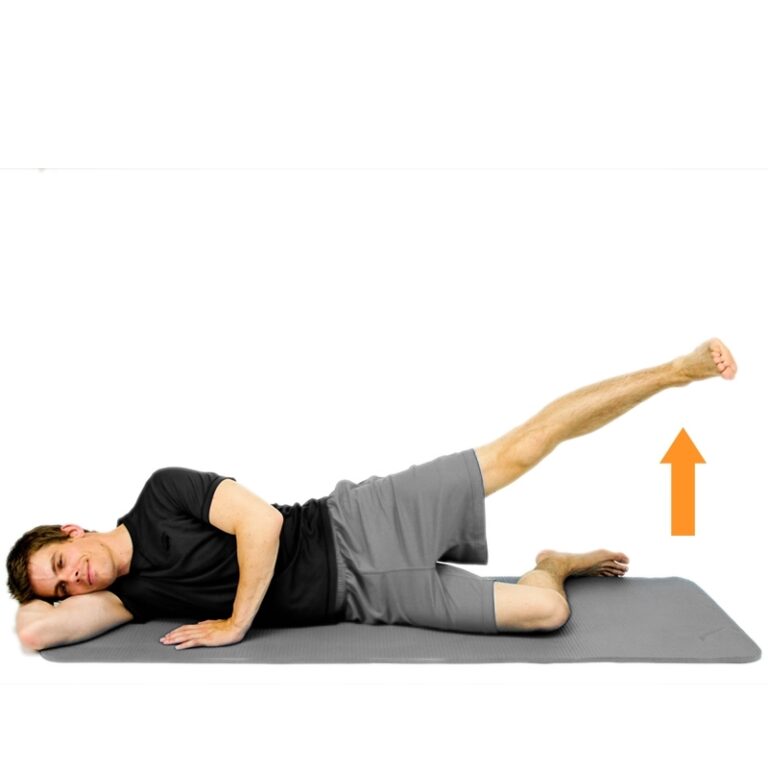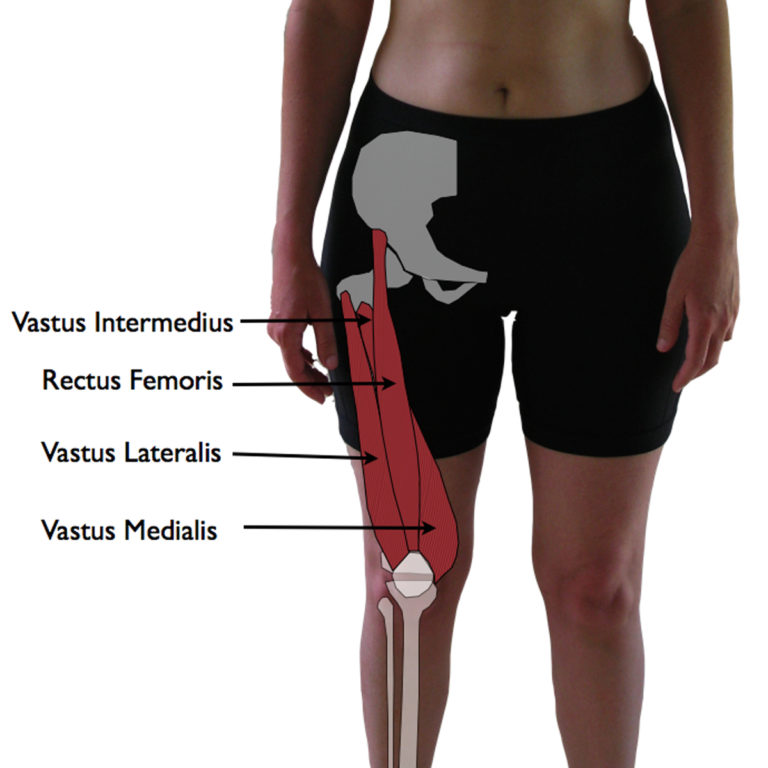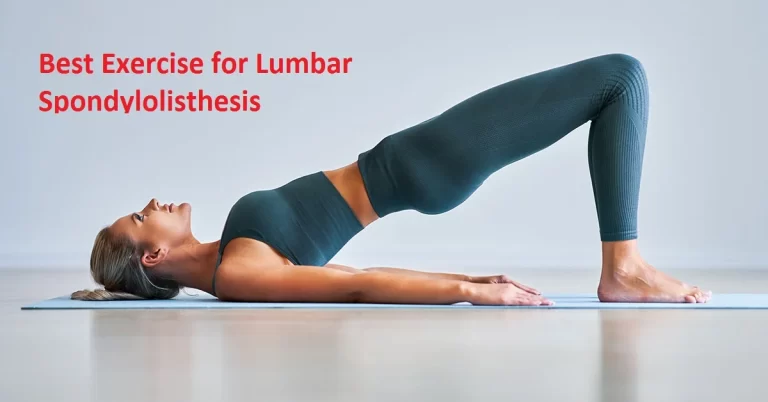53 Best Exercise for Shoulder Tendonitis
Table of Contents
Introduction
Shoulder tendonitis or tendinopathy, a fairly common condition of the shoulder joints, is frequently observed in athletes because of the extreme amount of repeated stress exerted on the connective tissues and muscles of the rotator cuff and adjacent structures.
Fortunately, despite the complexity of shoulder tendonitis, rehabilitation is typically relatively straightforward; if you use the right techniques, symptom relief is virtually assured.
Following your doctor’s instructions, doing the right rehabilitation exercises that target the whole range of motion, and making sure the joint has enough rest are all crucial for treating shoulder tendonitis.
What is Shoulder Tendonitis?
Shoulder tendonitis, also spelled as “tendinitis,” is a common medical condition characterized by inflammation or irritation of the tendons in the shoulder joint.
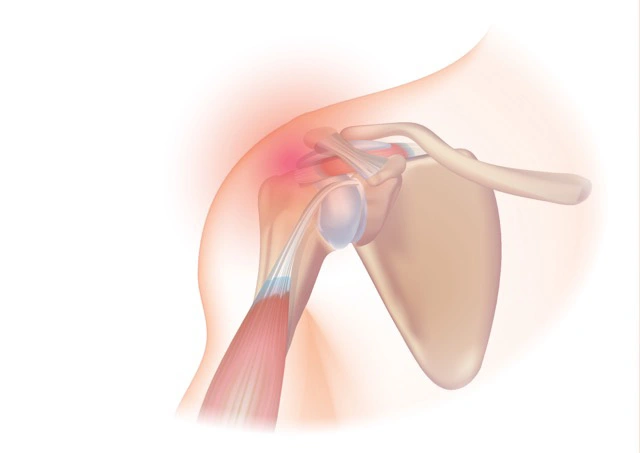
In the shoulder, several tendons form the rotator cuff, which plays a crucial role in stabilizing and moving the shoulder joint. When these tendons become inflamed or irritated, it can lead to shoulder tendonitis.
In activities where the arm is utilised above, such as swimming, baseball, and tennis, shoulder tendinitis is a frequent overuse ailment. When the arm is raised overhead or twisted, the pain, which is often felt at the point of the shoulder and refers or radiates down the arm, occurs. In severe circumstances, pain will be constant and can even wake you up from a sound sleep.
The shoulder joint is snugly fitted. The coracoacromial arch, a very narrow bone and ligament archway, allows the humerus (upper arm bone), the rotator cuff tendons that attach to the muscles that elevate the arm, and related bursa (friction-reducing membranes) to move back and forth. The archway narrows when the arm is elevated, compressing the tendons and bursa. The tendons and bursa in the arm are more vulnerable to damage and inflammation when used repeatedly.
A rotator cuff tendon develops tendinitis when it becomes inflamed, swollen, and painful.
Usually only lasting a few days, tendinitis and bursitis symptoms might return or progress to chronic conditions.
Inflammation of the rotator cuff or biceps tendon causes shoulder tendonitis, also known as rotator cuff tendonitis. When swelling traps or pinches a tendon against bones, tendonitis develops in the shoulder. When the arm is raised above or twisted, shoulder tendonitis pain frequently manifests as discomfort at the shoulder’s tip or spreading down the arm. Mild stiffness to excruciating pain are all possible symptoms.
The connective tissues of the shoulder girdle are the primary focus of shoulder tendonitis, a chronic overuse condition.
The majority of non-degenerative shoulder tendonitis instances are brought on by a person’s occupation or preferred sport that often requires overhead or externally rotating movements.
What are Shoulder Tendonitis Symptoms?
Symptoms of shoulder tendonitis may include discomfort when moving. Other indications include:
- Pain: Persistent pain in the shoulder, particularly when lifting or moving the arm.
- Weakness: Weakened shoulder strength.
- Stiffness: Difficulty moving the shoulder joint.
- Swelling: Swelling and tenderness around the affected area.
- Clicking or Popping: Some individuals may experience clicking or popping sounds when moving the shoulder.
Common cause of shoulder tendonitis
The word tendinitis is created by adding the suffix -itis, which is Greek for “inflammation.” It is simply tendon irritation. An inflammation of the shoulder’s tendon from the rotator cuff to the biceps is known as shoulder tendinitis. The following are the primary causes of this injury:
Shoulder tendonitis can develop due to various factors, including:
- Overuse: Repetitive or excessive use of the shoulder joint, such as in sports activities like tennis or swimming, or in certain job-related tasks, can lead to tendonitis.
- Sports that require a lot of effort and repetition, as well as movements of a particular size, might be harmful. For instance, it happens frequently to baseball pitchers.
- Age: As individuals age, the tendons naturally degenerate and become more susceptible to injury and inflammation. In older people with osteoarthritis, joint stiffness may be a risk factor.
- Poor Posture: Maintaining poor posture for extended periods, especially in activities like desk work, can contribute to shoulder tendonitis.
- Heavy or repetitive work, such as that done by bricklayers and blacksmiths.
- Trauma: A sudden injury, fall, or impact to the shoulder can damage the tendons and cause inflammation.
- Unstable shoulder joint
Diagnosis
Your healthcare professional will conduct a thorough health history and physical assessment. You may also require diagnostic testing like:
X-ray. Invisible electromagnetic energy beams create pictures on film of inside tissues, bones, and organs.
Ultrasonography. High-frequency sound waves generate a picture of some region of your body’s interior.
MRI. Large magnets and a computer create detailed photographs of your body’s organs and systems.
Treatment
- Rest- Avoid activities that cause discomfort or make it worse the next day. Avoid engaging in the behavior that caused the issue. The use of a sling to immobilize the shoulder may be advised by your doctor.
- Ice- At least twice every day, for 20 minutes, place an ice bag (over a towel), on your shoulder. After any action that makes your shoulder ache worse, you should also apply ice.
- Medications- While your body is undergoing its normal healing process, your doctor may advise you to take anti-inflammatory/analgesic medicine (in tablet form). It could be advised to administer a cortisone injection together with novocaine to the shoulder. Don’t do any strenuous activity with your arm for at least two weeks after getting an injection.
- Physical therapy- Your doctor could recommend that you receive therapy or exercises from a physical therapist. A recurrence may be avoided with shoulder strengthening exercises.
- Surgical treatments- Shoulder tendonitis and bursitis may need to be surgically treated if they become persistent or if a rotator cuff tear occurs.
How Exercise Can Help You Recover From Shoulder Tendonitis
For two reasons, persistent physiological ailments need physical rehabilitation:
- Ensuring that the wounded region continues to operate at its full potential.
- By enhancing localized blood flow and related biological processes, hastens the patient’s recuperation.
These advantages can be attained by methodically combining stretching exercises with those that use little resistance to elicit a stronger reaction from the tissues around the damaged area.
This usually entails that the patient undertakes stretches that make use of the typical biomechanics of the shoulder joint, including complete rotation, overhead arm extension, and stretches that influence the adjacent shoulder tissues.
Remember that the goal of these exercises and stretches is not to strengthen the shoulder joint but rather to maintain the patient’s complete range of motion and strength despite the effects of the tendonitis, enabling them to resume their normal activities without suffering any physical impairment.
Exercises for shoulder tendonitis
Pendulum Exercises:
These exercises can help improve mobility and reduce stiffness in the shoulder joint.
- Place your unaffected shoulder on the table while you stand next to it with your feet somewhat wider than shoulder width apart.
- The afflicted arm should be let to dangle down towards the floor while you bend your hips about 75 to 90 degrees.
- By shifting your weight from side to side, you may freely swing your arm.
- Letting your arm swing freely from front to back, shift your weight forward and backward.
- After becoming comfortable to these motions, try moving your body such that your arm swings in a circle while being cautious not to utilise your shoulder muscles to drive the motion. Aim for a circle that is no larger than 8 inches.
- continue for 30 more seconds. Increase the time daily until you can perform it for 3 to 5 minutes.
- Repeat for 5-10 times a day.
Shoulder Pulley:
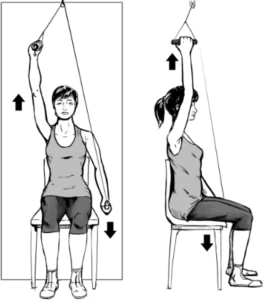
In physical therapy, a shoulder pulley is a tool frequently used to stretch the shoulder or rotator cuff while emphasizing proper upper body mechanics. Take hold of a pulley, and place it over a door. To begin, take a chair and sit right under the door, holding a handle in each hand. You can choose to have your palms facing forward or inward.
After that, simply switch between raising one arm at a time as high as is comfortable. Keep your upper shoulder and neck low and away from your ears as your arm lifts.
Up to 20 repetitions on each arm, holding for 5 to 10 seconds at the end of each repetition. You can experiment with lifting the arm in various positions, such as out straight or at an angle.
Finger walk:
It may be done as part of a home fitness regimen.
Maintain an arm’s length distance from the wall while you stand in front of it.
Slowly extend one arm out and place your fingers against the wall.
As high as you can safely reach, raise your arm and slowly move your fingertips up the wall.
Then descend your fingers to their original position.
Ten to twenty times.
Repeat 10 to 20 times with the other arm, then stop.
Wand exercise:
Both a supine and a seated position are acceptable for doing it. Additionally, carry out regular workouts at home.
Flexion of shoulder:
While standing, you hold the stick with both hands. When you hold the stick, your palms should be facing down. Keeping your elbows straight, slowly raise them above your head until you feel a stretch in your arms, allowing your entire arm to push your arm up. Hold for 5-10 seconds. Repeat 5-10 times. Do 2-3 times a day.
Abduction:
While standing, you hold the stick with both hands. The palm should face up on the injured side and down on the uninjured side. Rest the stick against the front of your thigh and, keeping your elbow straight, slowly raise it to the side of your injured arm. Now move the bar away from the body, press one arm to the side with the other, and up as high as possible. Hold for 5-10 seconds. Repeat 5-10 times. Do 3-5 times a day.
Extension:
In a standing position, hold the bar behind your back with both hands. Keeping your elbow straight, move the bar away from your back and push one arm out with your other hand. Hold the final position for 5-10 seconds. Relax and return to the first position. Repeat 5-10 times. Do 3-5 times a day.
Shoulder internal and external rotation:
While standing, hold the stick with both hands. Place your elbows at your sides and bend 90°. Move your hand and wand from side to side. With the other hand, push one arm away from the body while keeping the elbow at the side. Hold for 5-10 seconds. Repeat 5-10 times. Do 3-5 times a day.
Passive Internal Rotation:
The supraspinatus is the primary muscle engaged. This stretch should be felt in the front of your shoulder.
A light stick, such as a yardstick (wooden ruler), is required.
Do 4 times on each side for 5 to 6 days each week
Detailed instructions:
One hand should hold the stick behind your back while the other hand should only loosely hold the opposite end.
Pull the stick horizontally as demonstrated, passively stretching your shoulder until you can feel a pull without experiencing any discomfort.
30 seconds of holding, followed by 30 seconds of relaxation.
On the opposite side, repeat.
Advice: Avoid slouching or angling to one side while pulling the stick.
Standing Row:
Middle and lower trapezius are the primary muscles used.
This exercise should feel good in your upper back and the back of your shoulder.
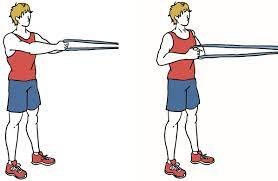
Use a comfortable resistance elastic stretch band as your equipment. Increase the number of repetitions to three sets of 12, as the exercise gets simpler to complete.
Detailed instructions
With the elastic band, create a 3-foot loop and join the ends. Connect the loop to a sturdy item, such as a doorknob.
As described in the starting position, stand, holding the strap in the crook of your elbows and at your sides.
Gently pull your elbow straight back, keeping your arm close to your side.
Back to starting point and again do it.
Tip: As you pull, squeeze your shoulder blades together.
External Rotation with Arm Abducted 90°:
This exercise should cause you to experience pain in your upper back and the back of your shoulder.
Use an elastic stretch band with a manageable resistance as your equipment. Move up to three sets of 12 repetitions as the exercise gets simpler to complete.
Detailed instructions:
With the elastic band, create a 3-foot loop and join the ends. Connect the loop to a sturdy item, such as a doorknob.
As illustrated in the starting position, stand holding the band with your elbow bent 90 degrees and elevated to shoulder height.
Raise your hand gradually until it is parallel to your head while maintaining a level shoulder and elbow.
Back to starting point and again do it.
Make sure your elbow and shoulder remain in alignment.
Scapula Setting:
This exercise should feel good throughout your upper back and shoulder blade.
Materials required: None
Ten repetitions each week: three
Detailed instructions:
With your arms at your sides, prone lying
If necessary, put a cushion beneath your forehead for comfort.
Draw your shoulder blades as closely together and as far down your back as you can.
Take a step away from this posture about halfway and hold it for ten seconds.
Ten times while relaxing.
Avoid tensing up in your neck.
Seated shoulder press exercise:
The muscular mass of the shoulders will be strengthened using a sitting shoulder push. To avoid aggravating the injury, it is recommended to perform this exercise with a machine press rather than free weights or barbells.
First, take a seat on the bench and take a firm hold of the press. If you utilise free weights or light barbells, be careful to hold the barbell with your hands shoulder-width apart and position it comfortably on your shoulders.
Use your shoulder muscles to slowly raise the barbell while seated.
At last, gradually return the barbell to its initial position.
Side lying external rotation with towel:
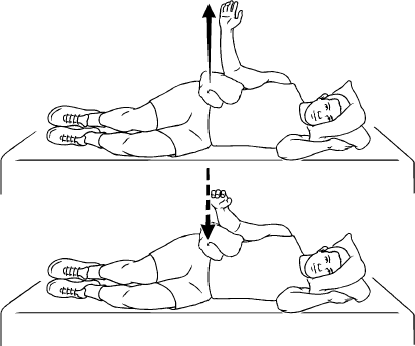
Your elbow should be bent to 90 degrees while you lay on your side.
Place a towel that has been wrapped up between your arm and the side of your body.
Hold that position by pulling your shoulder blades back and down towards your buttocks.
Next, keep your arm pressed on the towel and raise your shoulder blade all the while, rolling it upward from your stomach area toward the ceiling.
Then lower your arm once again.
Repetition: 10 Wait for one second
whole three sets Perform only once each day.
Scapular protraction- free weight- serratus punches:
Lay on your back and raise an arm out in front of you, towards the ceiling, while holding a small free weight.
Protract your shoulders forward while maintaining your elbow straight, then drop them back down in a controlled manner.
Avoid letting your shoulder incline towards your ears.
Throughout, keep your elbow straight.
Repetition: 10 Wait for one second
whole three sets Perform only once each day.
Table slide exercise:
Sit down on the stool or chair. Place your hands on top of the table’s towel.
Your elbow should be extended in both directions and moved back as you slide your hands away from your body. so that you extend your trunk and forward.
Go back to the beginning place.
You may also do a shoulder abduction by sliding your afflicted hand away from your body while sitting at the edge of the table.
Perform 10 to 15 repetitions.
“Gear Shift” Exercises:
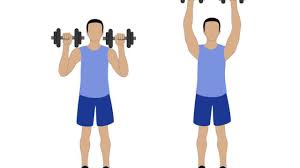
Position of the patient and protocol: The patient is sitting, holding a cane or wand with the tip lying on the floor to support the weight of the patient’s arm, and the injured arm is at the side. Ask the patient to move the cane in a manner similar to changing the gears on a car’s floor: in flexion, extension, diagonally, laterally, and medially.
Side lateral raise:
The side lateral raise, a shoulder exercise, involves:
- Put your feet apart and hold dumbbells at your sides while you stand.
- Lift both dumbbells simultaneously to shoulder level.
- Keep arms slightly bent, exhale at the top, and pause.
- Lower the dumbbells with control and inhale.
- Complete desired reps (typically 8-12) for 2-4 sets.
Focus on proper form, avoid swinging, and use a weight that suits your strength level. This exercise targets the lateral deltoids for broader shoulder development.
Arnold Press:
The Arnold Press is a shoulder exercise:
- Sit on a bench with back support.
- Grip dumbbells with your palms facing up at shoulder level.
- Press the weights overhead while rotating your palms away.
- At the top, your palms face forward.
- Lower the dumbbells while rotating your palms back to the starting position.
- Perform 8-12 reps for 2-4 sets.
This exercise targets various shoulder muscles and helps build shoulder strength and definition.
Stretching exercises
You can assist in restoring shoulder range of motion by performing the stretches shown below. Each stretch should be performed gently to give the muscles and soft tissues time to extend, and it is okay to go as far as you feel comfortable with the stretch. Each stretch hold for 30 seconds. Your objective when stretching is to achieve your greatest range of motion. Before stretching, it is advised that you warm up thoroughly. Before stretching, you should often perform some light exercise like walking, cycling, or running to get your heart rate up.
Permit the first one or two reps to be very lightly painful warm-up reps. As you start to feel more flexible, gradually extend your range of motion. Even while stretching occasionally causes little discomfort, it is not advised to “push through the pain”. The arm will loosen up as it heats up, so be patient. Perform 5 to 10 reps, two or three times each day.
Stretching exercises for shoulder tendonitis can help alleviate stiffness, improve range of motion, and reduce tension in the shoulder area. Here are some gentle stretching exercises that may be suitable for shoulder tendonitis:
Supine External Rotation Stretch:
lying on your back with your elbows bent at a 90-degree angle and your arms abducted. Allow the backs of your hands to fall towards the floor with the palms facing down towards your feet, contacting the floor if you can, until you feel a stretch in your shoulders and/or chest. The pec muscles and internal rotators will be stretched as a result.
Hold for 2-3 sets of at least 30 seconds. You may also attempt this stretch or other versions on a foam roller to lengthen the stretch.
Stretch Internal Rotation:
Start out gently and maintain good posture. Avoid allowing the stretched shoulder (and shoulder blade) to droop or fall forward.
To begin, grab a towel or stretch strap. Grab the end of the strap with the arm you wish to extend behind your back and palm outward. The top of the strap will then be placed over the shoulder on the other side using your other hand. The lower hand should then be guided as high up the center of the back as possible using the upper hand.
Hold for 2-3 sets of at least 30 seconds. With this stretch, you should be able to touch your shoulder blades and mid-back.
Supine passive arm elevation:
Lay down on your back. Hold a cane or stick in both hands, spacing your hands about 18 inches apart while you hold it. Lift the cane upward while holding on to the damaged arm while keeping the elbows straight and helping with the opposite arm. Return the arm to the bed gradually. In order to avoid pain, as much raising and lowering as possible should be done with the healthy arm throughout this exercise.
Stretch with hands behind the head:
Lay down on your back. As in the top image, place your hands behind your head. Stretch the shoulder towards the position seen in the bottom image by gradually lowering the elbows.
Ten seconds of holding this position is followed by a return to the beginning position.
Perform 10 reps twice a day.
Behind-the-back internal rotation:
Position the damaged arm’s hand at your waist while standing or sitting on a chair. To assist the other hand move higher towards the shoulder blade, as shown, and pull on a towel with the opposite hand.
Horizontal abduction:

With one arm hanging straight down to the floor, lie face down on a table or the edge of a bed. When your arms are parallel to the floor, raise them out to the side while keeping your thumbs pointing up. Hold for two seconds before gradually lowering it. Start off with no weight for this exercise. Add a small weight as you gain strength, or hold a soup can. Do three sets of ten.
Scaption:
Elbows should be straight when you stand with your arms at your sides. Bring your arms slowly up to your eyes. When you lift your arms, they should be wide apart and at a 30 degree angle to the front of your body, just slightly in front of your torso. Your thumbs should be pointing up. Hold for two seconds, then gently drop your arms. Do three sets of ten. When performing the exercise, hold a soup can or a small weight; as the activity becomes easier, increase the weight.
Stretching the Shoulders on a Quadruped:
There are several ways to flex the shoulders, including this one. With both hands immediately beneath your shoulders, begin on your hands and knees. Then, just pull your chest closer to your thighs and the ground while shifting your butt back towards your feelings. Keep moving until your shoulders and/or upper back feel strongly stretched.
Hold for up to three sets of 30+ seconds each. Alternately, if tolerated, you can lay your hands on an exercise ball to get a deeper stretch. To extend the shoulder into a more abducted position, you can also rotate your spine to one side.
Behind-the-Back Stretch:
Stand up straight. Reach your affected arm behind your back. Use your unaffected hand to grasp your affected hand or wrist. Gently pull your affected arm upward. Hold for 15-30 seconds.
Wall Crawl Stretch:
Put your fingertips at waist height against the wall as you stand facing it. Slowly crawl your fingers up the wall, walking your fingers higher. Continue until you feel a gentle stretch in your shoulder. Hold for 15-30 seconds. Reverse the motion by walking your fingers back down.
Cross-over Shoulder Stretch:
The crossing shoulder stretch, also known as the cross-chest shoulder stretch, is a common pre-exercise mobility exercise that aims to provide a static stretch for the shoulder and arm’s lateral adduction biomechanics.
By simply pressing with the opposing hand on the elbow of the arm that is being stretched, resistance may be adjusted to the patient’s degree of discomfort.
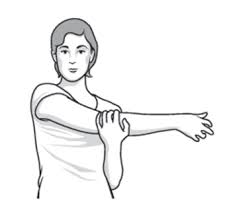
How-to:
- The patient will extend the arm of the injured side loosely across the sternum while holding the elbow of that arm with the opposing hand to do the cross-chest shoulder stretch.
- The patient will then move the elbow across their body while gently pushing with the other hand until they feels a stretch over the back and medial side of their deltoid muscles.
- The arm must be kept in this posture for a brief period of time before being released, completing the stretch.
Chair Shoulder Flexion Stretch:
The chair shoulder flexion stretch is a variant of the classic shoulder flexion exercise that strengthens the shoulder flexion biomechanic by using an anchor (specifically, a chair).
It can be done unilaterally or bilaterally and is typically thought to have very little influence, which explains why frozen shoulder rehabilitation plans frequently include it.
How to:
The patient will stand around an arm’s length away from a chair or other equally solid item of low elevation to conduct the chair shoulder flexion stretch.
Then bend at the waist and bring the arms into a parallel plane with the body, or at least as far as the shoulder’s effective range of motion can go while placing both palms on the back of the chair.
The patient completes the stretch by holding this position for many counts before standing back up.
Sleeper Stretch:
The sleeper stretch is regarded as a crucial component of any successful shoulder rehabilitation program since it extends the entire shoulder structure in a simple, low-impact manner.
Furthermore, because it is done while lying down and is regarded as an isolation stretch, it is very beneficial for people who also have other injuries.
Patients are recommended to practice this stretch with a pillow supporting their neck and shoulders for the most comfort.
How-to:
The patient should lie on their side with the injured shoulder facing the floor to start the sleeper stretch.
They will then extend their arm forward, bending the elbow so that the hand is pointed squarely upwards.
The patient then bends the arm towards the floor holding the wrist or forearm with the opposite hand keeping the elbow bent. After reaching the maximum effective range of motion of the injured shoulder, they hold this position for several seconds before letting the arm release, ending the stretch.
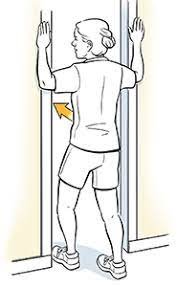
Doorway Stretch:
This stretch strengthens your shoulders while opening up your chest.
With your elbows and arms at a 90-degree angle, stand in a doorway.
Put your palms into the sides of the door frame and advance with your right foot.
Forward flexion of your core as you lean. For up to 30 seconds, maintain this posture.
By putting your left foot forward, repeat the stretch.
2 to 3 times on each side.
Pectoralis doorway stretch- low:
Place your lower arm on the door frame as you stand in a doorway and slant your body inward until you feel a stretch along the front of your chest and/or shoulder. Along the door frame, with your arm extending downwards towards the floor.
NOTE: Your knee should be bent or straightened through the doorway to regulate how far you extend.
3 times in a row 30 Seconds of Hold
1 Set Complete One time every day, perform
Upper Body Stretches
Because of their close ties, the neck, shoulder blades, and upper back frequently experience stiffness and discomfort in addition to the shoulder. For relief, try these stretches.
Neck release:
Take a seat on a cosy chair to extend your neck. Bend your neck sideways and bring your left ear near your left shoulder. To deepen the stretch, keep the right shoulder blade down and relaxed while extending the right arm out to the side (and slightly back). Right between your shoulder blades and the side of your neck, you’ll feel a significant stretch. Stretch the left side by switching.
Hold for four sets of at least 30 seconds on each side. Use the hand on the other side of you to exert more pressure for a deeper stretch.
Neck and Trap Stretch (for upper trapezius muscle):
Move your right ear towards your right shoulder slowly and comfortably. Your left shoulder will naturally raise when you do this. If that occurs, slowly bring your head back to the middle until you can let your left shoulder fall back into place.
Place your right hand on your left cheekbone as you raise it over your head. But just now, don’t pull on your skull. Just place your palm there to apply a little bit of extra pressure. Your upper trapezius will be softly stretched as a result.
Sit here for at least 30 seconds as you breathe.
Release this side gently, then, while deep breathing, move your left ear towards your left shoulder to finish the stretch there.
Back clasp:
It helps improve the flexibility of the shoulder muscles and ligaments. It also helps restore the full range of motion to the injured shoulder. Stand straight, legs apart. Slowly raise your arms up and bring them behind your head. Place your hands behind your back. Keep your arms steady and slowly raise them above your head. At the moment of greatest resistance, halt and keep still for 30 seconds. Repeat 10-15 times. Do this 2-4 times a day.
Shoulder Rolls/Shrugs:
To perform this exercise properly and securely, follow these steps.
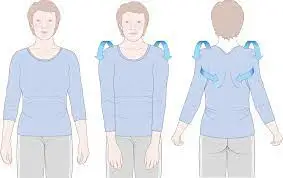
Start by standing up straight with your feet planted firmly on the ground.
Turn your hands inside while keeping your arms at your sides. If you’re using weights for the workout, stoop down and collect them right away.
Your knees should be slightly bent so that they touch (but do not extend past) your toes. Maintain a straight back, a high chin, and forward-facing gaze.
While inhaling, raise your shoulders as close to your ears as you can. Move gently so that you can feel your muscles’ resistance.
Before reversing the motion, raise your shoulders again and exhale.
Start with three sets of 10 repetitions. As your shoulder strength improves, you can increase the amount of repetitions.
Try gradually increasing your workout frequency to 3 sets of 20 repetitions, 4 times per week.
Quadruped Thoracic Rotation:
Start with your hands directly beneath your shoulders while you are on your knees. The lower spine will then be locked into position as you flex your hips and drop your butt towards your heels (they do not need to touch). Put one hand behind your head, elbow bent at a 90-degree angle. Rotate the spine while pointing the elbow up towards the ceiling while keeping the other hand on the ground. Repeat from your starting position.
On each side, repeat 8 to 10 times. Keep your movement slow and under control. Even at the peak of each motion, you can hold. With each exercise, you should be able to rotate more deeply and feel a stretch in your upper back.
Shoulder Strengthening Exercises
Starting rotator cuff, shoulder blade, and upper back strengthening activities is now necessary as your shoulder range of motion increases.
Always begin gently while beginning a new workout to get a feel for it before moving on.
Strengthening the shoulder using theraband:
Strengthening exercises using a Theraband can be beneficial for individuals with shoulder tendonitis to help improve shoulder stability and alleviate symptoms. However, it’s essential to start with light resistance and gradually progress to avoid exacerbating the condition.
These resistance exercises should be performed in both directions very slowly. The objective is to strengthen as much as possible while paying attention to your location of pain.
Always move within a range of motion that is pain-free, and perform the exercises very gently. The muscular contraction is better across the range of motion the slower the motion is. Each exercise should be performed 15 to 20 times, one to two times each day.
External Rotation:
Theraband should be fastened at waist level to a strong anchor point, such as a door handle.
As you stand, face the anchor point with your side.
With your elbow bent at a 90-degree angle, hold the band in the hand of the injured shoulder.
Against the band’s resistance, rotate your forearm outward and away from your body.
Go back to the beginning position gradually.
Each arm should receive 2-3 sets of 10-15 repetitions.
Internal Rotation:
A sturdy anchor point should be used to fasten the Theraband, much like external rotation.
Face your side away from the anchor as you stand.
Hold the band with your afflicted shoulder’s hand while maintaining a 90-degree bent elbow.
Against the band’s resistance, rotate your forearm inside, towards your body.
Return to the starting position gradually.
For each arm, do 2-3 sets of 10–15 repetitions.
Shoulder Flexion:
Place the Theraband at the hip level.
Stand facing the anchor point with both hands on the band.
Starting position: Arms at sides, palms facing thighs.
Raise both arms until they are at or just above shoulder level, forward and upward.
Ideally, your arms are now at your sides.
5 sets of 15 repetitions should be done.
Shoulder Abduction:
Place the Theraband at the hip level.
Stand facing the anchor point with both hands on the band.
Start by standing with your arms at your sides, palms up.
Raise both arms until they are shoulder-height, outward and upward.
Ideally, your arms are now at your sides.
5 sets of 15 repetitions should be done.
Scapular Retraction:

At waist level, secure the Theraband.
With your back to the anchor and Theraband in both hands, stand.
Start by raising your hands to chest level and extending your arms forward.
Pull your arms back, bend your elbows, and squeeze your shoulder blades together.
Go back to the beginning position gradually.
Perform 3 sets of 5-10 repetitions.
Shoulder shrugs with a Theraband:
While holding the Theraband, stand with your feet shoulder-width apart.
Maintain straight arms with palms facing thighs.
Squeezing the shoulder blades while lifting the shoulders towards the ears.
Retain for a brief moment.
Drop your shoulders as you exhale.
To develop the trapezius muscles, perform 2-3 sets of 10-15 repetitions.
Theraband biceps curl:
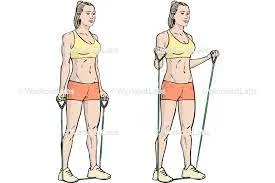
While holding the Theraband, stand with your feet shoulder-width apart.
Maintain straight arms with palms facing thighs.
Squeezing the shoulder blades while lifting the shoulders towards the ears.
Retain for a brief moment.
Drop your shoulders as you exhale.
To develop the trapezius muscles, perform 2-3 sets of 10-15 repetitions.
Theraband adduction
Using a Theraband, start with the elbow straight and the arm 45 degrees away from the body at the side. Pull your arm inward toward the front of your thigh. Slowly return to the starting position. Do 20 reps, one to two times a day.
Theraband punch exercise:
Secure the Theraband at chest height.
Stand facing the anchor point.
Hold the Theraband handles with both hands at chest level.
Punch forward, extending your arms fully.
Control the return to the chest.
Do 2-3 sets of 10-15 reps for upper body strength.
Y-Raises (for scapular stability):
Place the Theraband at the hip level.
Stand facing the anchor point with both hands on the band.
Starting position: Arms at sides, palms facing thighs.
Form a “Y” shape by raising both arms diagonally upward and outward.
Ideally, your arms are now at your sides.
5 sets of 15 repetitions should be done.
T-Raises (for scapular stability):
Place the Theraband at the hip level.
Stand facing the anchor point with both hands on the band.
Start by standing with your arms at your sides, palms up.
Form a “T” with your arms by raising them both straight out to the sides.
Ideally, your arms are now at your sides.
5 sets of 15 repetitions should be done.
Prone Rows (for upper back and shoulder stability):
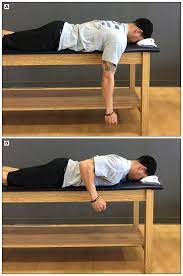
Place the Theraband at the hip level.
Place the band in your hands and lay face down on a bench or exercise ball.
Straighten your arms and reach them towards the ground.
Squeezing your shoulder blades together, raise both arms back.
Retract your arms to the floor.
5 sets of 15 repetitions should be done.
Wall Angels (for scapular mobility):
Stand with your back to a wall and one foot or less between you and the wall.
One end of the Theraband should be in each hand while you hold it.
Your palms should be facing forward when you begin with your arms at your sides.
Make a “Y” form by raising your arms aloft while maintaining them in touch with the wall.
Ideally, your arms are now at your sides.
5 sets of 15 repetitions should be done.
Isometric exercise
Shoulder flexion:
Face the wall as you stand.
Make a fist with the elbow extended on the side of the shoulder you wish to work.
Your hand should be softly pressed onto the wall with a towel wrapped in between it and your fist.
Hold for five seconds, then gradually let go. Simply apply light pressure to the wall to engage your shoulder muscles.
If it hurts, stop doing it.
Perform 10 to 15 times.
Extension:
To do an isometric shoulder extension, have the patient stand with their back to a wall, about seven inches away.
Maintain a stretched elbow so your hand is resting close to your hip.
Making a fist with the afflicted side, slowly rotate the arm outwards while gently pressing the rear of the arm onto the wall.
Hold for five seconds, then gradually let go of the wall.
Perform 10 to 15 times.
Abduction of the shoulder:
To conduct isometric shoulder abduction exercises, place one’s torso perpendicular to a wall while standing seven inches away from it.
The shoulder on the impacted side must be near the wall.
Make a fist at the afflicted side and push it into the wall. For a little more comfort, place a folded towel between the hand and the wall.
Give the wall a little push, then hold it for five seconds.
Release the wall’s pressure gradually.
Count from 10 to 15 times.
Isometric External Rotation of the Shoulder:
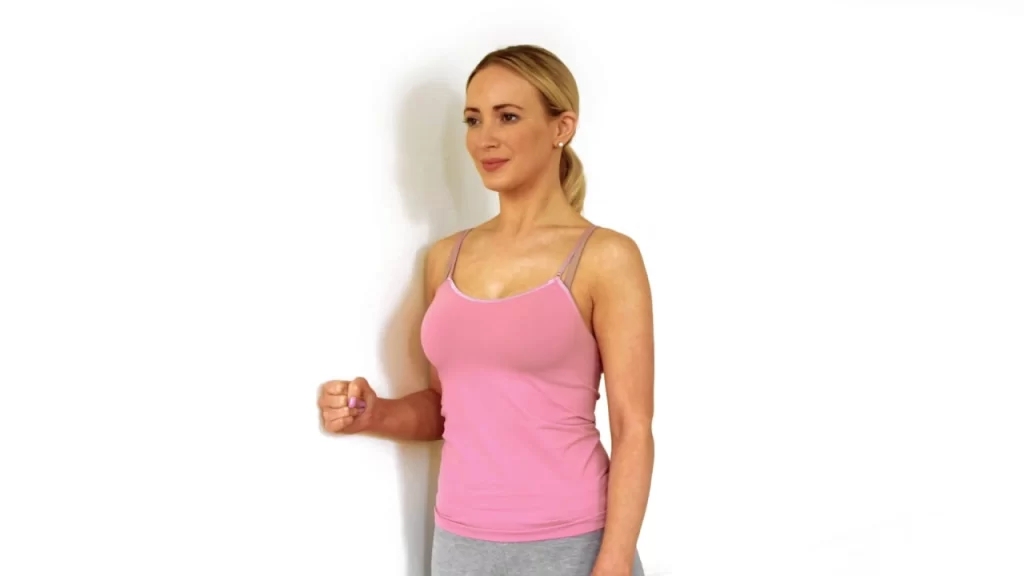
The teres minor and infraspinatus muscles of the rotator cuff, in particular, can be strengthened with this exercise.
To carry out the exercise for shoulder external rotation:
Stand seven inches away from a wall perpendicular to it.
The shoulder on the impacted side needs to be closest to the wall.
Make a fist with the afflicted side, flexing the elbow to 90 degrees, and turning the arm outwards while pressing the back of the hand against the wall.
Hold the pressure for about 5 seconds while you gently press into the wall.
Release the wall’s pressure gradually.
Perform 10 to 15 times.
Isometric Internal Rotation of the Shoulder:
To do an isometric shoulder internal rotation, stand with your body parallel to a wall and your face facing a door frame at the outer corner of the wall.
Close to the door opening should be the shoulder of the side that is afflicted.
When attempting to rotate your hand inward towards your belly, flex the elbow 90 degrees, create a fist on the side that is being impacted, and gently press the afflicted fist toward the wall.
For added comfort, use a folded towel.
Take a 5-second hold of it.
Count from 10 to 15 times.
Resisted exercise
Resisted External & Internal Rotation:
For this one, get a light to medium resistance band.
External rotation
Simply place your hands shoulder-width apart, bend your elbow, and grip the band with your palms facing up. Next, twist the shoulders while pulling your hands apart and pinching your shoulder blades together. You should only move inside your comfort zone.
For 2-3 sets, perform each repeat for 10-15 times.
Internal rotation
Face the band sideways and fasten it to a door at the level of your navel. Once more with the elbow bent, place the band in the arm closest to the band and pull across your body towards your belly button. Throughout, keep your elbow tucked into your side, and relax your neck.
For 2-3 sets, perform each repeat for 10-15 times.
Resisted Shoulder Flexion & Abduction:
Use a mild to medium resistance band at first. With both hands, hold the band around 3 feet apart.
Flexion
With both hands, hold the band around 3 feet apart. For stability, place the hand that won’t be moving on the same hip. Return to the beginning position after lifting the other shoulder as high as you can forward and straight up towards the ceiling.
For 2-3 sets, perform each repeat for 10 times on each hand.
Abduction
Take the identical actions you did during the flexion exercise, but place your hand on the hip on the other side. Next, extend the shoulder as far to the side as you can while keeping it straight.
For 2-3 sets, perform each repeat for 10 times on each hand. In order to avoid irritation, use additional caution when doing shoulder abductions.
Resistance Band Chest Expansion Exercise:
This exercise for tendinitis of the shoulder is indicated in the later stages of physical rehabilitation when the shoulder has regained most of its stability and can sustain tension for a short period of time.
As the name suggests, the chest resistance band extension requires a resistance band or similar source of resistance.
How to:
To perform the resistance band chest expansion exercise, the patient attaches the band to a stable object behind them, holding the opposite end with both hands while placing the arms behind the body.
Once this position is achieved, the patient simply pulls the scapula inward pushing the ribcage outward, taking advantage of the ability to rotate the shoulder joints.
This practise should be repeated as many times as necessary.
Quadruped Lateral Taps
This is a more advanced workout that combines stability in the shoulders and the core. Get down on your knees and hold a resistance band in each hand, exactly below the shoulders. Lift one hand off the floor and move it as far away from your body as you can while maintaining proper posture in the spine. Tap each side in succession.
For 2-3 sets, perform 10 to 15 repetitions on each arm.
Shoulder squeezes
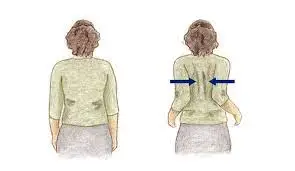
Take care to sit or stand straight.
Place your hands on your shoulders, thumbs in the back, and fingers in front.
Lightly compress the area between your shoulder blades.
Hold for a few seconds before releasing.
Continue for 2-3 sets of 10-15 repetitions to increase shoulder and upper back mobility.
Table-top presses
Sit on a back-supported bench or chair.
Dumbbells should be held at shoulder height.
Lift the weights above your head.
Reposition them at shoulder height.
For shoulder strength, perform 2-3 sets of 10-15 repetitions.
Side rotation
You begin by lying on the ground, bending your elbows to a 90-degree angle, and placing your forearms on your abdomen.
Maintaining your elbows close to your body, prepare a dumbbell, and then elevate it to the ceiling gradually.
Refrain from rotating your arms if you are under any strain.
Hold it there for a short while, then turn it around to the beginning position.
Repeat the exercise by lowering your arm.
Rowing exercise
Wear a resistance band before working out.
Raising the knee across from the hurt arm while lowering the other.
The knees and the body must line up.
The second hand should be placed on the lifted knee.
Take hold of the resistance band.
Pull your elbows close to your body while extending your arms.
Straight your back and for a brief period of time, squeeze your shoulder blades, then let go.
You can stand stationary or spin your body with your arms. Maintain your stance.
Go back to the beginning place.
10 times more sets.
Flying exercise
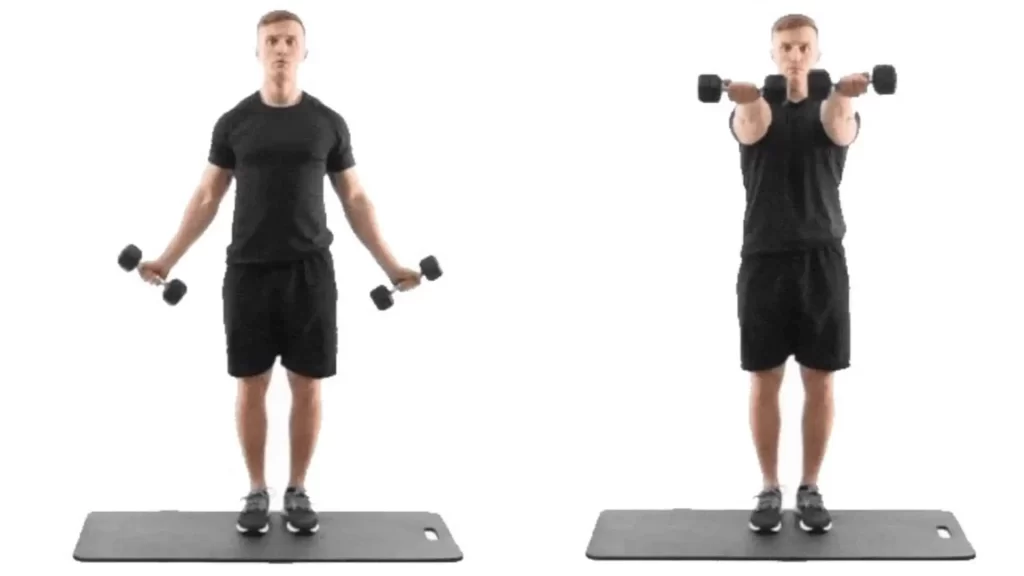
With your feet apart and your shoulders back, stand upright.
Straighten your back, lean forward at the waist, and bend your knees just a little.
Holding onto each hand while extending your arms
Pull your shoulder blades together as you raise your arms away from your body.
Keep your arms below your shoulders.
Return to the starting position and perform the exercise once again.
Lawn Mowing
Similar to a lawnmower, this. One of the best exercises for shoulder tendonitis treatment is this one.
Place one end of the resistance band under your feet after standing up straight, separating your shoulders, and separating your feet.
With the second arm, cross it across your body and hold the other end of the resistance band.
Now put your other hand on your hips while bending a little.
On the other side, place the strap parallel to the knee.
Like a lawnmower, go about it. Stretching and pulling with the elbows along the body’s outer ribs should continue.
For a brief period of time, squeeze your shoulder blades, then let go.
Rerun the activity.
Door leaner
The door leaner is a straightforward workout. So, the following is the procedure:
Put your arms up by the wall first, then raise them above your head.
Slowly lean forward as though stretching out from your shoulders.
For 15 to 20 seconds, hold.
Rerun the activity. Make careful to stretch it just a little and do it softly.
Benefits of exercise for shoulder tendonitis:
Exercise can offer several benefits for individuals with shoulder tendonitis. While it’s important to approach exercise with caution and under the guidance of a healthcare professional or physical therapist, when done correctly, exercise can help manage and improve the condition.
- Pain Reduction: When performed correctly and gradually, exercises can help reduce pain associated with shoulder tendonitis. Targeted exercises can strengthen the muscles around the affected tendons, which can provide better support to the shoulder joint and reduce the strain on the inflamed tendon.
- Improved Range of Motion: Shoulder tendonitis can lead to stiffness and limited range of motion in the shoulder. Specific exercises focused on mobility and stretching can help improve the flexibility of the shoulder joint. This can enhance your ability to perform everyday tasks and activities without discomfort.
- Muscle Strengthening: Strengthening the muscles around the shoulder joint is a crucial aspect of managing shoulder tendonitis. Stronger muscles can better support the shoulder joint, helping to alleviate some of the stress placed on the tendons during movement. Resistance exercises and targeted strength training can be beneficial in building muscle strength.
- Prevention of Recurrence: Regular exercise can reduce the risk of shoulder tendonitis recurrence. Strengthening and conditioning the shoulder muscles can make them more resilient to repetitive movements or overuse, reducing the likelihood of reinjury.
- Enhanced Functionality: The ultimate goal of shoulder tendonitis treatment is often to restore full shoulder functionality. Gradual and progressive exercises can aid in regaining strength and function, allowing you to return to normal daily activities and, in some cases, sports or recreational activities.
- Non-Surgical Approach: Exercise is often considered a conservative, non-surgical treatment option for shoulder tendonitis. It can be an effective means of managing the condition and avoiding more invasive treatments like surgery.
- Improved Quality of Life: By reducing pain, enhancing range of motion, and restoring functionality, exercise can significantly improve the overall quality of life for individuals with shoulder tendonitis. It allows them to perform daily tasks with less discomfort and participate in activities they enjoy.
How Long Is Physical Therapy for Shoulder Tendonitis?
Every situation is unique, so your physical therapist will create a treatment plan that is tailor to your needs and the seriousness of your ailment.
While a more severe incidence of shoulder tendonitis may require up to 12 weeks of treatment, a minor instance of the condition should only require six to eight weeks of therapy.
seeking assistance How soon you seek medical attention for your accident will have a significant impact on how long you need physical therapy and how rapidly you heal.
How Often Should I Workout?
Your shoulder injury stage will determine how frequently you should perform workouts.
The early stages of recuperation will include one to three stretching exercises per day along with pain management methods.
You’ll concentrate on regaining strength and function as the discomfort subsides. Try to work out your shoulders three to five times a week.
The ultimate objective is to continue a maintenance program 2 to 3 times per week as you recover full function.
Avoid these Exercises if You Have Shoulder Pain
You’ve undoubtedly read about specific exercises, like this one or this one, that can help you get on the path to recovery if you or someone you know has had a shoulder-related injury.
Particular workouts, especially in the early phases of recovery, might irritate the shoulder joint and result in a rotator cuff rupture. Exercises to avoid if you have a shoulder injury include the following:
Repetitive overhead movements, such as swimming and throwing
Performing intense weightlifting, especially pulldowns and overhead presses
Any arm elevation that has the thumbs pointing downward or upright rows
Any further movements that hurt, aggravate or result in shoulder impingement
- Weightlifting Above Your Head
Exercises involving pushing or overhead motions should be avoided at first for those with shoulder issues. Put aside sports like ball tossing and focused weightlifting at the gym like overhead presses and pulldowns. These motions might put more strain on the damaged region, leading to increased damage and discomfort.
2. Pulldown from behind the neck
This is an activity to avoid if you have shoulder tendonitis, whether you’re using a barbell or a bar hooked to a cable. This motion places unnecessary strain on the rotator cuff, increasing your chance of developing further shoulder issues and developing chronic discomfort.
The behind-the-neck pulldown has difficulty with “external rotation.” You must externally rotate your shoulders as much as possible during the behind-the-neck pulldown, which is a highly sensitive posture for your shoulders. By doing this action, you run the risk of injuring your joints and overstretching your tissues.
3. Standing Row
Even though upright rows are one of the most popular exercises in the gym, a brief glance at the exercise’s mechanics will show you why it’s not a good choice for rotator cuff and other shoulder issues.
The position your arms must be in during the workout is where the issue is. Internal rotation is the name give to this posture. A tiny tendon in your shoulder is compressed by the shoulder bones as you raise your arms. This might lead to excessive wear and tear over time.
Although you might not notice it right away, the tendon will progressively deteriorate and cause injury.
4. Presses Behind The Neck
A behind-the-neck shoulder press exercise, such as the Military Press, might hasten the onset of injury.
To do the behind-the-neck press exercise, you must externally rotate your shoulders as much as possible. This can place considerable pressure on your rotator cuffs and puts your shoulders in a susceptible position for the bones in your shoulder girdle, which links your backbone to your arms. Furthermore, research indicates that most men lack the necessary mobility to successfully do the behind-the-head shoulder press. Another justification for avoiding this exercise is if you have shoulder tendinitis.
5. Bench Dips (Tricep Dips)
The tricep muscles are the primary muscle group use during dips. Unfortunately, dips are on the “no” list because they involve too much internal shoulder rotation and risk rotator cuff traction.
The humeral head will translate forward when the shoulder is approaching the limit of extension, which is required to perform dips.
Tips for Shoulder Tendinitis
To maximize the benefits of your shoulder training program, remember these quick tips:
- Make careful you warm up and cool down properly. Start and conclude with moderate stretches and movements that encourage blood flow to sore, damaged regions.
- Start out gently and try to keep the stretching exercises passive.
- Maintain proper posture and form. To avoid squeezing inflamed tissues and to improve balance, keep your shoulders back, your neck relaxed, and your chin tucked.
- Use in combination with massage, TENs, cold, heat, and other pain-relieving methods.
- Maintain consistency. The best potential function and pain alleviation for the shoulder can be achieved by regular stretching and strengthening.
- Ask a physical therapist for advice. Consider a session of physical therapy if you’re not sure where to begin or want to maximize your healing outcomes. They will work with you to develop a personalized treatment plan and understand your injury.
Getting Rid of Shoulder Pain
Shoulder discomfort is not enjoyable. Your ability to perform the activities you enjoy and your sleep quality may both be impacted. You may start along the path to recovery by following a regular workout routine that correctly addresses pain, flexibility, and strength. Make sure to contact your doctor as soon as you can for medical advice if your symptoms intensify or don’t appear to be improving.
FAQs
Shoulder tendonitis, also known as rotator cuff tendonitis, is the inflammation or irritation of the tendons in the shoulder joint, particularly those of the rotator cuff muscles. It can cause pain, limited range of motion, and discomfort in the shoulder area.
Shoulder tendonitis is often caused by repetitive overhead arm movements, such as those performed in sports like tennis or swimming, or in certain occupations. Aging, overuse, and acute injuries can also contribute to the development of tendonitis.
Common symptoms include shoulder pain, especially when lifting the arm or sleeping on the affected side, weakness in the shoulder, and limited range of motion. Pain may radiate down the arm.
A healthcare provider typically diagnoses shoulder tendonitis through a physical examination, evaluation of symptoms, and possibly imaging tests like X-rays or MRI scans to rule out other conditions.
Treatment may include rest, ice, physical therapy, anti-inflammatory medications, corticosteroid injections, and modifications to daily activities.
It can be prevented or minimized by avoiding repetitive overhead movements, maintaining good posture, using proper lifting techniques, and warming up before engaging in physical activities.
Every situation is unique, so your physical therapist will create a treatment plan that is tailored to your needs and the seriousness of your ailment.
While a more severe incidence of shoulder tendonitis may require up to 12 weeks of treatment, a minor instance of the condition should only require six to eight weeks of therapy. seeking assistance How soon you seek medical attention for your accident will have a significant impact on how long you need physical therapy and how rapidly you heal.
It’s essential to consult with a healthcare provider or physical therapist for guidance on exercise. In some cases, modified exercises and rehabilitation programs can help manage and improve shoulder tendonitis.
Untreated shoulder tendonitis can lead to chronic pain, loss of shoulder function, and the development of more severe conditions like rotator cuff tears, which may require surgical intervention.
Yes, it is possible for shoulder tendonitis to recur, especially if the underlying causes or risk factors are not addressed. Proper rehabilitation, lifestyle modifications, and ongoing shoulder care can help prevent recurrences.
In some cases of mild shoulder tendonitis, rest and avoiding activities that aggravate the condition may lead to spontaneous improvement. However, more severe or chronic cases often require treatment to alleviate pain and promote healing.
Common risk factors include repetitive overhead arm movements (e.g., in sports like swimming or tennis), aging, occupations that involve repetitive shoulder movements, poor posture, and previous shoulder injuries.
It’s essential to consult with a healthcare provider for guidance on whether you can participate in sports or physical activities. In some cases, modifying your activities and following a rehabilitation program may allow you to continue certain activities while managing your condition.
Shoulder tendonitis involves inflammation or irritation of the tendons in the shoulder, whereas a rotator cuff tear is a physical tear or rupture of one or more of the tendons in the rotator cuff. The symptoms and treatment for these conditions can differ, so an accurate diagnosis is crucial.
While shoulder tendonitis itself does not directly cause a frozen shoulder, it can contribute to shoulder stiffness and limited range of motion, which are common symptoms of a frozen shoulder. Timely treatment and physical therapy can help prevent or manage such complications.
Physical therapy is often a key component of shoulder tendonitis treatment. A physical therapist can provide exercises and techniques to improve shoulder strength, flexibility, and range of motion while reducing pain and inflammation.
Heat can help relax muscles and improve blood flow, which can be soothing for some individuals with shoulder tendonitis. Cold therapy (ice) can reduce inflammation and provide pain relief. Consult with a healthcare provider to determine which therapy is more suitable for your specific situation.
Surgery is typically considered a last resort for shoulder tendonitis and is only recommended when conservative treatments fail to provide relief. Most cases of shoulder tendonitis can be managed without surgery.
To prevent recurrence, it’s essential to address underlying risk factors, maintain good shoulder mechanics, perform strengthening exercises, practice proper posture, and avoid overuse or repetitive movements that can strain the shoulder tendon
Reference
Luna, D. (2023, June 13). Shoulder Tendonitis: 5 Stretches and 5 Exercises (with Pictures!). Inspire US. https://www.inspireusafoundation.org/shoulder-tendonitis-exercises/
Hyderabad, S. C., & Hyderabad, S. C. (2021, June 16). Shoulder Tendonitis Exercises For Shoulder Pain Relief – Shoulder Clinic Hyderabad. Shoulder Clinic Hyderabad – Just Another WordPress Site. https://hyderabadshoulderclinic.com/shoulder-tendonitis-exercises-for-shoulder-pain-relief/#:~:text=Like%20other%20exercises%20to%20treat,squeeze%20your%20shoulder%20blades%20back.
Patel, D. (2023, April 18). Best Exercise for Frozen Shoulder: Mobility Physiotherapy Clinic. https://mobilephysiotherapyclinic.net/best-exercise-for-frozen-shoulder/#Passive_ROM_Exercises
12 Stretches & Exercises for Shoulder Tendonitis. (n.d.). Vive Health. https://www.vivehealth.com/blogs/resources/exercise-for-shoulder-tendonitis
About sportmed.com/wp-content/uploads/Shoulder_tendinitis.pdf – Google Search. (n.d.). https://www.google.com/search?q=About+https://sportmed.com/wp-content/uploads/Shoulder_tendinitis.pdf&tbm=ilp&biw=1536&bih=747&dpr=1.25
Britton, W. (2021, October 11). Physical Therapy for Shoulder Tendonitis: How it Can Help, Exercises, and More. PRO~PT. https://pro-pt.net/treatments/shoulder-problems/physical-therapy-for-shoulder-tendonitis/
Rotator Cuff Tendinopathy Exercises New York | Shoulder Exercises New York. (n.d.). Jaspal Ricky Singh, M.D. https://www.rickysinghmd.com/rotator-cuff-tendinopathy/
Rotator Cuff and Shoulder Conditioning Program – OrthoInfo – AAOS. (n.d.). https://orthoinfo.aaos.org/en/recovery/rotator-cuff-and-shoulder-conditioning-program/
Ghodadra, N. (2022, July 20). Shoulder Injury Exercises 101: Shoulder Tendonitis Exercises To Avoid & Rotator Cuff Exercises To Avoid. Torrance Orthopedic Surgeons & Doctors. https://rollinghillsmedical.com/shoulder-tendonitis-exercises-to-avoid-fastest-recovery-treatment/
Articles. (n.d.). https://www.cedars-sinai.org/health-library/diseases-and-conditions/s/shoulder-tendonitis.html
Cronkleton, E. (2023, February 3). Top 10 Exercises to Relieve Shoulder Pain and Tightness. Healthline. https://www.healthline.com/health/shoulder-pain-exercises#doorway-stretch
Stelter, G. (2018, September 29). Stretches to Loosen Your Trapezius Muscles. Healthline. https://www.healthline.com/health/fitness-exercise/trapezius-stretches#ear-to-shoulder
Watson, K. (2019, June 18). Benefits of Shoulder Shrugs and How to Do Them. Healthline. https://www.healthline.com/health/fitness-exercise/shoulder-shrugs#how-to




